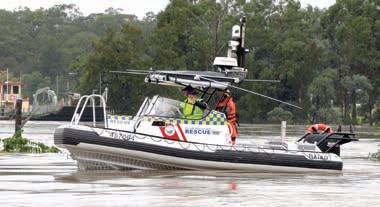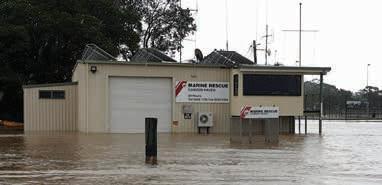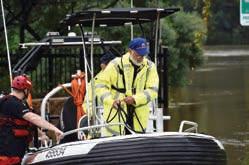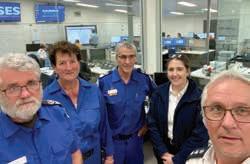
13 minute read
MUD MISSION. A special report on the NSW flood crisis
Volunteers quick to join flood crisis response
Mass support operation demonstrates our expanding capability, versatility.
Marine Rescue NSW was on the frontline of the mammoth emergency response to the March flood crisis, helping communities from the Mid North Coast to Western Sydney swamped by the worst flooding to strike the state in decades.
In its first large-scale, coordinated flood support operation, MRNSW provided on-water, logistical and incident management personnel and resources to the multi-agency response led by the NSW State Emergency Service.
Demonstrating the service’s expanding capability and versatility, crews swapped their blue water operations to navigate down muddy flooded streets, over parks and fields and across swollen, debris-filled waterways along the coastline and hinterland from Port Macquarie to Colo, west of Sydney.
Director Operations Andrew Cribb, who was based at the SES State Headquarters for the response operation, applauded the service’s volunteers for their community spirit and willingness to step into a new environment to support their emergency services colleagues and help people in need.
“We were pleased to be able to deploy our assets and trained personel to assist in an operation of this scale, with such large areas of the state flooded,” he said.
“Our volunteers played a valuable role, evacuating people from floodwaters, isolated houses, caravan parks and in one instance, half-way up a tree.
“They carried out welfare checks and resupply missions, they filled sandbags and they transported local government staff to inspect and repair public infrastructure needed for community health and transport.
“Our people quickly adapted to new operations in difficult conditions to help those worse off.”
He said members from Merimbula, Batemans Bay, Ulladulla, Port Macquarie and Lake Macquarie had demonstrated their emergency management expertise in Incident Control and Emergency Operations Centres and a Cottage Point volunteer had joined operations at Sydney’s Public Information Inquiry Centre to ensure the community was well-informed.
Others had ensured frontline crews were well fed and rostered duties covered, while yet others got to work on the clean up of their own flooded facilities, with the Port Macquarie, Camden Haven, Nambucca and Tuggerah Lakes bases all inundated.
The flood crisis began on the Mid North Coast, with crews from MR Port Macquarie, Camden Haven and Crowdy Harrington joining evacuation operations from March 19.
Members of MR Port Macquarie filled shifts around the clock for six days straight, working with other emergency services to rescue residents, including a six-monthold baby, from flooded homes and caravans. In contrast, a crew from MR Crowdy Harrington evacuated two elderly women, aged 83 and 94, from their isolated farms to their families.
An out-of-area deployment was assembled with volunteers from MR Ulladulla, Tuggerah Lakes and Broken Bay heading north to Taree to operate on the Manning River.
Over four days, the crews, with three smaller boats, evacuated residents, including a pregnant woman and a veteran Olympic swimmer, carried out welfare checks of people whose homes were surrounded by a sea of brown water and supported local council staff.
By March 22, a regional taskforce of more than 30 volunteers, seven vessels and a fuel trailer from the Norah Head, Central Coast, Port Kembla, Shoalhaven, Sussex Inlet, Alpine Lakes, Merimbula, Tuross and Batemans Bay units had joined members of Botany Port Hacking in a deployment to Western Sydney. The Hawkesbury, Cottage Point and Broken Bay units were already on standby.
Commissioner Stacey Tannos met the taskforce members in Sydney and later inspected flooded facilities.
“All of our people, both volunteers and staff, gave 100 per cent, no matter their role,” he said. “They all deserve our heartfelt thanks.”
Street light to starboard! MRNSW crew members navigate carefully around a power pole peeking through deep flood water on the Hawkesbury River near the Sackville Ferry. Photo: Brad Whittaker.

Golden girl a ray of sunshine in the tempest
Taree taskforce evacuates Olympian, mum-to-be and two men up a tree.
Marine Rescue NSW vessels have the power to reach the scene of an emergency FAST but one person evacuated by our volunteers at the height of the flood emergency quipped she could probably swim faster than the rescue boat was travelling on the swollen Manning River.
Volunteers from MR Broken Bay, Ulladulla and Tuggerah Lakes were deployed to provide out-of-area support to emergency operations on the Manning at Taree South.
MR Ulladulla Unit Commander Dave Hall, Deputy David Lindley and Phil Anthony left the South Coast in the small hours of Saturday, March 20, to rendezvous with MR Broken Bay Commander Jimmy Arteaga, Deputy Andrew Majewski, Gavin Jarvis and Matt Colahan and MR Tuggerah Lakes members Steve Corbett and Craig Roberts. After reaching their staging point, they spent an afternoon filling sandbags with the SES.
With UC Hall acting as MRNSW Liaison Officer at the Taree council depot, the crews formed a discrete taskforce and were tasked to evacuate residents from harm’s way, undertake welfare checks and transport local government staff to inspect critical wastewater infrastructure.
When they headed out on board UL 10 to evacuate one elderly woman trapped by the rising river while attending a funeral, they discovered to their surprise that their passenger was Olympic Gold and Silver medallist Lorraine Crapp.
Lorraine was the first woman to break the five-minute barrier in the 400m freestyle.
UC Arteaga said the golden girl had been in fine spirits, joking that she could swim faster than the boat.
Lorraine wasn’t the only person helped to safety by the MRNSW team. A pregnant woman was ferried to a waiting NSW Ambulance and as the Broken Bay crew were making their way down the flooded Manning, they caught sight of two men wedged in trees on the far river bank. With the water levels on the river high up the trees, the men were frantically waving for help.
The pair had been making their way along the river in a kayak, without lifejackets, to deliver food and supplies to one of their elderly mothers, who had not wanted to leave her isolated home.
UC Arteaga said the pair had been unable to make their way against the swirling current and dragged into the trees in “the middle of nowhere”.
“They’re lucky we caught them out of the corner of our eye,” he said. BB 20 transported the pair to deliver their supplies to a very grateful mum.

Veteran Olympian Lorraine Crapp was in fine fettle as the MRNSW Taree taskforce evacuated her to safety.

Convoy ... MR Tuggerah Lakes, Ulladulla and Broken Bay crews rendezvous on their way to join flood operations at Taree.
Flood debris creates risks for safe boating
Debris washing down waterways and out to sea continued to pose a hazard to boaters weeks after the floodwaters had receded.
A NSW Environment Protection Authority operation to clear refuse from riverbanks on the Mid North Coast and Northern Rivers was still under way in mid-June, with assistance from three local MRNSW units.
Marine Rescue issued warnings in the wake of the flooding, advising boaters to keep a careful watch for dangerous submerged and floating debris, including garden sheds, 44 gallon drums, fridges, furniture and other household items.
Deputy Commissioner Alex Barrell said the risks were exacerbated by lost or displaced navigation aids and channel markers, as well as floodwaters surging down rivers and across coastal bars.
“With chemicals, deceased stock and wildlife and other pollutants washed into waterways, boaters also needed to exercise extra caution to avoid the risk of being thrown overboard,” he said.

A crew from MR Iluka Yamba took this yacht under tow after murky floodwater surging down the Clarence River prevented it from crossing the bar at Yamba, pushing it back out to sea.
Unit base swamped as river breaks its banks
Major works needed to repair damaged Camden Haven equipment, wharf.
When the most severe floods in years swept through the Camden Haven area in March, the Marine Rescue base was not spared.
Sitting right on the Camden Haven River, the unit’s ground floor was quickly inundated, along with homes and businesses in North Haven, Dunbogan, Kendall and other low-lying areas around the river.
While many of its volunteers suffered damage to their properties and vehicles or were cut off by floodwaters, this did not prevent the unit rallying to assist community members in need of help.
Unit Commander Neville Adams said the unit had moved its 4x4 towing vehicle and small vessel, Camden Haven 10, a 4.2m Zodiac, out of the shed and to a member’s home above the flood level.
“This proved the correct decision as this small vessel was extremely useful in enabling us to conduct several rescues to evacuate people from harm’s way,” he said.
“But with several members facing their own flooding or with roads cut off, we only had two crew available, John Evans and Ken Rutledge.”

One-and-a-half metres of muddy floodwater sweep through the Marine Rescue Camden Haven base, damaging and destroying equipment, fittings and furniture.
The pair were tasked to medivac a pregnant woman from the Diamond Waters caravan park but on arrival, found she had made her way safely to hospital.
Two people were evacuated from the nearby Dunbogan caravan park.
Commissioner Stacey Tannos and Deputy Commissioner Alex Barrell visited the base in April to inspecct the damage caused by the 1.5m of muddy floodwater that swept through the facility.
When the waters receded, the damage included ruined wall linings, amenities and equipment, including a launch winch for vessel CH 30, lifejackets, uniforms, cupboards, a fridge, stove and the bathroom. The unit’s wharf and slip rails also will need to be replaced after being damaged by debris.
UC Adams said the floods had brought hardship to many people, causing major damage to homes, motor vehicles and personal items.
“The area will take months, if not longer, to recover,” he said.
“Several of our local caravan parks like Brigadoon, Dunbogan and Diamond Waters suffered major damage and losses.”
UC Adam said after a working bee by members to clean and repair what they could, the unit was slowly getting things back on track.
“The radio room is fully operational again but it will take quite some time yet to have all assets replaced or repaired and back into full service,” he said.
Ken Rutledge
Regional taskforce rallies to the frontline and
Volunteers from regional areas of the state rallied to join a Marine Rescue taskforce to support flood operations in Western Sydney.
Units with smaller vessels that could be towed hit the highways to join their Sydney colleagues.
Along with the boats and a fuel trailer, members from MR Norah Head, Central Coast, Port Kembla, Shoalhaven, Sussex Inlet, Tuross, Merimbula, Batemans Bay and Alpine Lakes were deployed to the frontline and incident management.
MR Tuross Training Officer Blaise Madden was one of the crew on Tuross 20 supporting SES operations. Initially tasked to the SES Blacktown unit, where they helped out filling sandbags, the crew soon found themselves in the thick of it on the swollen Hawkesbury River at Sackville. “We quickly discovered that in a flood, ramps and moorings are what you can find at the time,” he said.
“At one point we had to reverse half a kilometre down a narrow road to the Sackville Ferry terminal to launch and ended up tying up to a telegraph pole right up near the light, so deep was the water.
“We supported a smaller SES boat as the ‘mother ship’ while they doorknocked local residents, all the while getting used to the unfamiliar flood environment.
“We learned a lot from working with the SES and other agencies and took home a few lessons to apply to the next deployment.” MR Merimbula Unit Commander Sonia Teston was one of three volunteers tasked overnight to the Sydney Metropolitan Incident Control Centre, comparing flood control to her experience in a bushfire Emergency Operations Centre.
“Both had the electric buzz of professional and focused dynamic activities. MRNSW obviously had a water related role with the floods, whereas our volunteers were active in the evacuation centres for the fires. In both, we were consulted as to our capability and capacity and we stepped up without hesitation. “Neither event required us to undertake activities for which we train, however, the mindset of our volunteers is such that we couldn’t do anything but help. You can’t be anything but proud of our volunteers,” she said.
Team works around clock to help community
Port Macquarie members evacuate more than 100 people from danger.
In pelting rain and on rapidly rising water courses, volunteers from MR Port Macquarie worked around the clock for six days straight to help members of their community in danger and devastated by the region’s flood crisis.
Crews filled shifts across 24 hours, working side-by-side with personnel from the State Emergency Service, NSW Police, Surf Life Saving and other emergency services.
Between March 19 and 25, they performed 32 rescues, relocating more than 100 people in cold, wet and windy conditions.
About 60 crew members were on rotation across every 24 hours, supported by a stream of their colleagues and kindly members of the public providing moraleboosting sustenance. Deputy Unit Commander Graham Gibbs was based in the local Emergency Operations Centre.
On the first night of the downpour, as the Hastings River broke its banks and flooded through the unit’s boat base, crews responded to calls to evacuate residents from flooded homes and the tops of caravans.

Muck and mud ... the crew of Port Macquarie 30 make their way carefully down the swollen Hastings River on a safety patrol, keeping a look out for debris and hazards that needed to be removed from the waterway.
Over the next five days, members transported more people from caravan parks along the river and steered over flooded roads and paddocks to reach isolated families. Along the way, 22 dogs, three cats and one lucky flying fox hitched a ride to safety on board PM 20.
The members’ ready access to the water also enabled them to save yachts in trouble on their moorings; help with a seaplane dislodged from its berth; relocate vessels and move houseboats to deeper water; assist a local boat hire business whose boat shed was taken out when the Settlement Point ferry cable snapped and then transport council engineers to repair the ferry infrastructure. Floating and submerged trees, logs, hay bales and hundreds of livestock in and around the river made for a treacherous and also distressing environment.
Meanwhile, other members were working to move what equipment they could from the muddy water swamping the unit’s boat shed.
Numerous items were lost or damaged and many key assets, including the shed’s main doors and winch, were forced out of operation.
The unit worked closely with other emergency services in a coordinated operation.
Our unit was even able to provide NSW Police with a spare blade for their flood boat prop when none could be found in the state, enabling them to remain fully operational.
It was an extraordinary effort by all involved, again demonstrating our team’s commitment to our community.
Michelle Rayner
incident control in sodden Western Sydney

MR Tuross Training Officer Blaise Madden was one of the regional taskforce of volunteers deployed to support SES flood operations, here in the thick of it on the swollen Hawkesbury River at Sackville. MR Merimbula’s Stewart Dietrich and UC Sonia Teston, Batemans Bay UC Richard Blundell, Development Officer Sophie Galvin and ROM Glenn Evans at the Sydney Metro Incident Control Centre.











